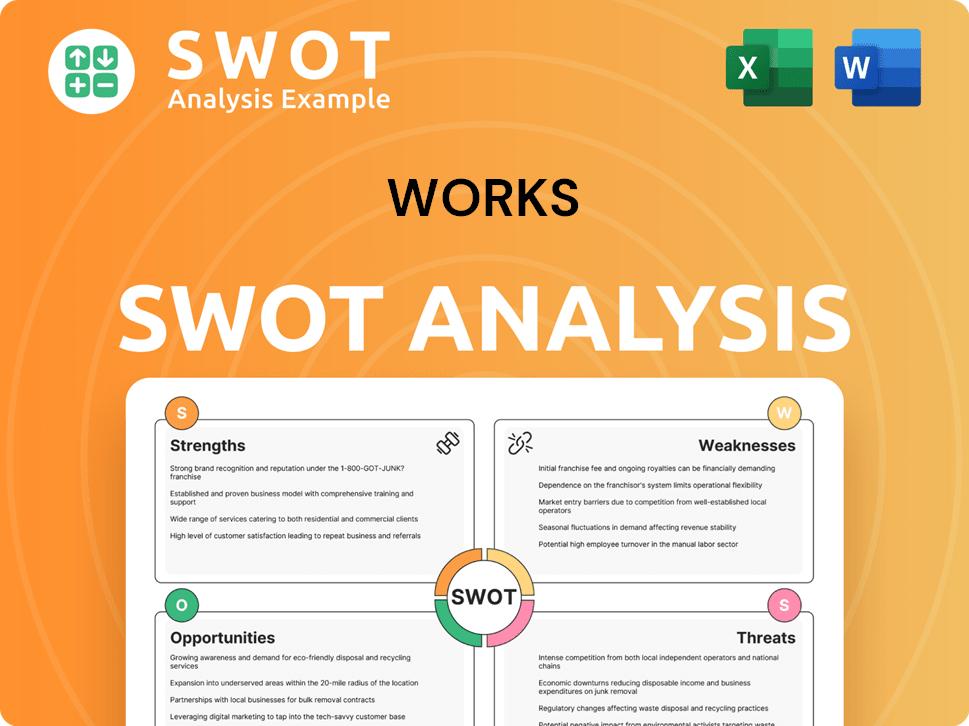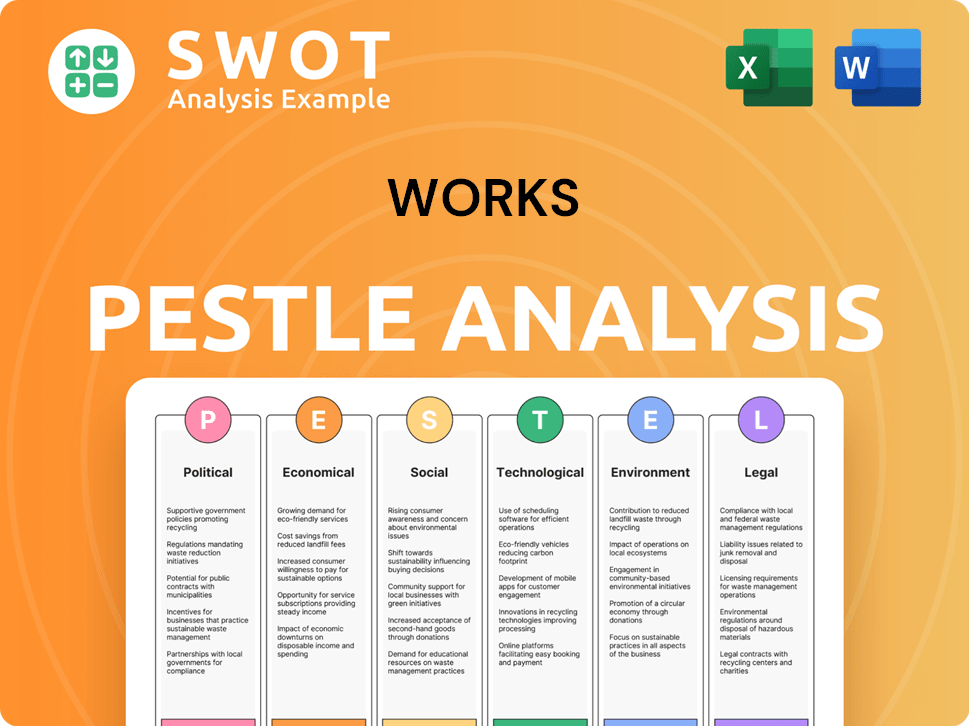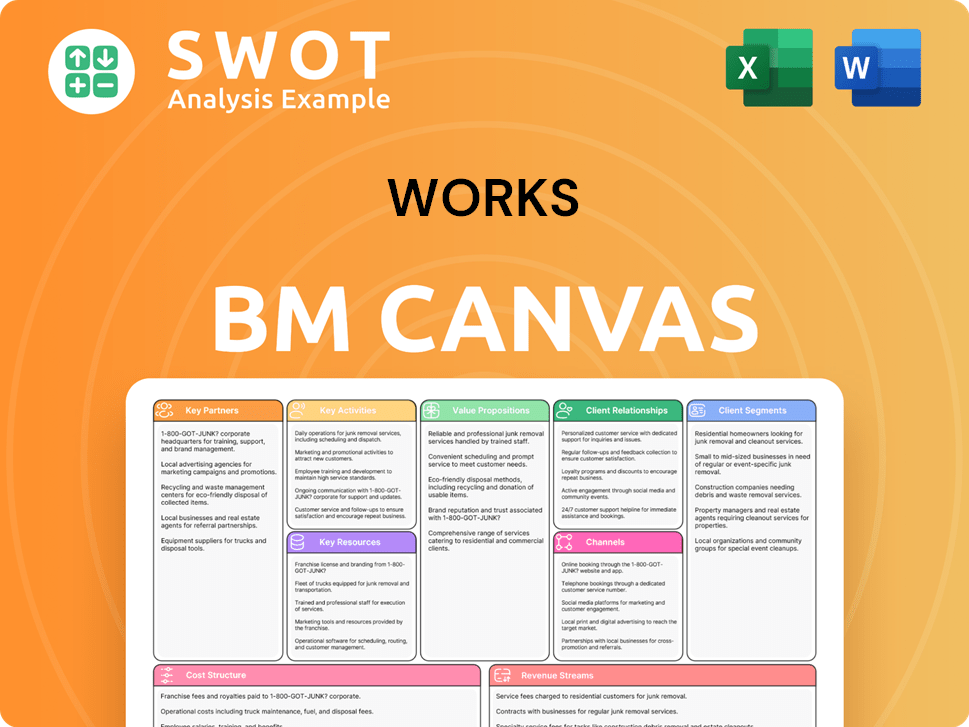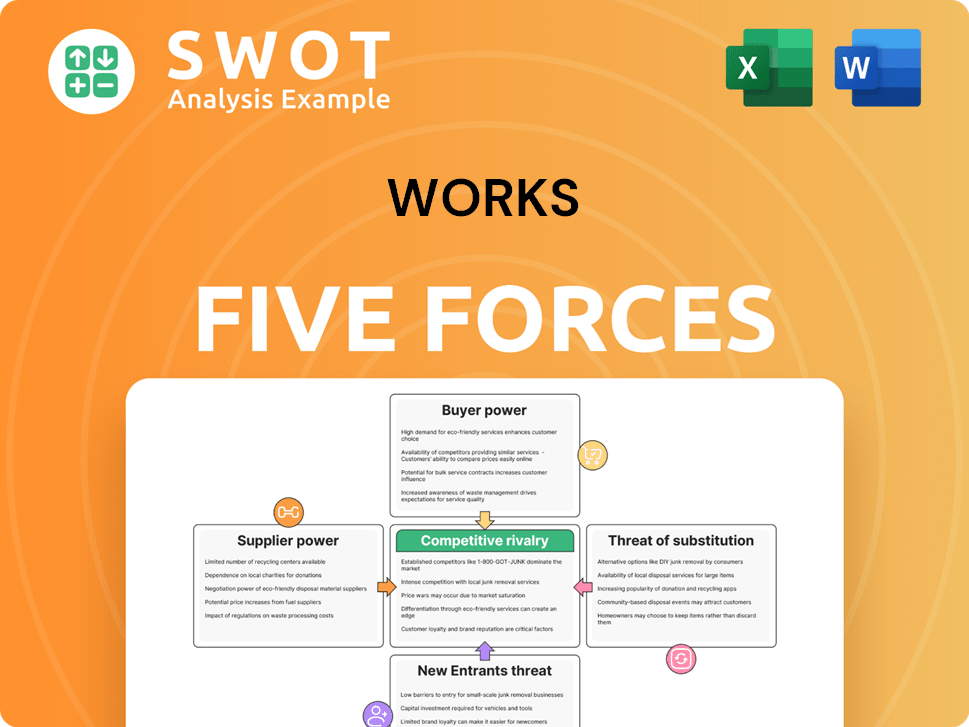Works Bundle
Can The Works Company Continue Its Growth Trajectory?
The Works, a well-known UK discount retailer, has carved a niche by offering value-for-money products. Founded in 1981, the company has evolved from a discount bookstore to a multi-category retailer with a strong online presence. With over 500 stores, The Works has shown resilience, achieving revenue growth in FY24. This analysis dives into the Works SWOT Analysis to uncover its growth strategy and future prospects.

This exploration will examine the Works Company's strategic planning, including its expansion plans and strategies. We'll delve into the key growth drivers, financial projections, and potential challenges the company faces. Understanding the company outlook is crucial for anyone interested in the future prospects of the Works Company and its ability to navigate the competitive retail landscape through effective business development.
How Is Works Expanding Its Reach?
The Works Company is implementing an ambitious growth strategy focused on expanding its market presence and diversifying its revenue streams. This involves both physical store expansion and enhancements to its online platform. The company's future prospects are tied to the successful execution of these initiatives, aiming for significant sales growth in the coming years.
The company's business development strategy includes opening new stores and improving its online offerings to attract and retain customers. These efforts are supported by strategic planning and investments in infrastructure and product development. The company's company outlook is optimistic, with plans to increase its market share and achieve its financial goals.
The company currently operates 506 stores across the UK and plans to open 60 new stores over the next five years. The goal is to increase sales to over £375 million by 2030. The company is focusing on approximately 100 target locations for expansion. In the first half of FY25 (26 weeks ended November 3, 2024), The Works opened three new stores and relocated two, while closing eight underperforming outlets, resulting in a net reduction of five stores. A further net reduction of five stores is expected by the end of FY25, with plans to resume growth with five new stores in 2026.
The Works plans to open 60 new stores over the next five years. This expansion is a key part of their growth strategy. The company aims to boost sales significantly through this initiative.
The company is improving its website to enhance the customer experience. This includes revamping the homepage and optimizing product pages. New analytical tools are also being implemented.
The Works is refining its product offerings with new toys, games, and a relaunched kids' book range. A new Commercial Director is leading these initiatives. This diversification aims to attract a wider customer base.
Transitioning to a new third-party online fulfilment provider is expected to reduce costs. This move will also improve service quality. The change is anticipated to benefit the company in FY26 and beyond.
The Works is also focused on enhancing its online platform to drive growth. They have made improvements to their website, including revamping the homepage, optimizing product pages, and improving site navigation. These changes have led to improvements in key metrics, laying the foundation for further online growth in 2024. The company is also testing new trading mechanics, such as limited-time discounts, web exclusives, and bundles, to engage customers more effectively. While online sales decreased by 14.7% in H1 FY25 due to planned lower promotional activity and reduced capacity at its fulfilment centre, the company expects these issues to subside and is transitioning to a new third-party online fulfilment provider, which is expected to deliver cost savings and a higher standard of service in FY26 and beyond. For more details on their customer base, check out the Target Market of Works.
The main drivers of The Works' growth strategy include store expansion, online enhancements, and product development. These initiatives are designed to increase sales and market share. The company is also focused on improving its operational efficiency.
- Store Expansion: Opening 60 new stores.
- Online Enhancements: Improving website and customer experience.
- Product Development: Introducing new toys, games, and books.
- Operational Efficiency: Transitioning to a new fulfillment provider.
Works SWOT Analysis
- Complete SWOT Breakdown
- Fully Customizable
- Editable in Excel & Word
- Professional Formatting
- Investor-Ready Format

How Does Works Invest in Innovation?
The Works Company is strategically leveraging innovation and technology to fuel its growth strategy. This approach focuses on enhancing the customer experience and optimizing its product offerings. The company aims to maintain affordable prices while making strategic improvements to its operations and product lines.
The company's focus on digital transformation and product innovation reflects its commitment to adapting to evolving customer needs. By improving its online platform and introducing new product ranges, the Works Company is positioning itself for future growth. The company is evolving its strategy to emphasize optimization and strategic initiatives.
The Works Company's approach to innovation and technology is centered around improving its product offerings and enhancing its digital capabilities. The company is focused on providing a better customer experience and maintaining affordable prices. This strategy is designed to drive sustained growth and adapt to changing market dynamics.
The Works Company has introduced new toy and game ranges, which performed well in the first half of FY25. The relaunch of the kids' book range in spring 2024 aimed to provide a clearer offering from baby and toddler books to young adult fiction. This included more fun-learning books and a broader range of titles.
The company has invested in improving its website and online platform. This includes revamping the homepage, optimizing product pages, and improving navigation. New analytical tools were implemented to enhance the customer experience.
The Works Company is testing new trading mechanics, such as limited-time discounts, web exclusives, and bundles, to engage customers online. The company is also focused on maintaining affordable prices for consumers. The company is committed to a 'better, not just bigger' strategy.
The company has started stocking more 'front-list titles' from well-known authors to improve its credibility as a bookseller. This move capitalizes on trends like 'BookTok'. This strategy aims to attract more customers and increase sales.
A new rewards scheme was scrapped in early 2024 to reduce costs. This decision reflects the company's focus on optimizing its operations and maintaining financial stability. The company is prioritizing initiatives that offer the best return on investment.
The company's strategic focus remains on maintaining affordable prices for consumers. The 'better, not just bigger' strategy, to be evolved and shared in early 2025, emphasizes optimizing existing operations and product offerings. This approach aims to drive sustainable growth.
The Works Company's growth strategy is driven by a combination of product innovation and digital enhancements. The introduction of new product ranges and improvements to the online platform are key initiatives. The company's focus on cost management and strategic initiatives supports its long-term goals.
- Product Range Expansion: New toy and game ranges.
- Digital Improvements: Revamped website and enhanced online platform.
- Customer Engagement: Testing of new trading mechanics.
- Cost Optimization: Scrapping of the rewards scheme.
- Strategic Focus: Maintaining affordable prices and optimizing operations.
Works PESTLE Analysis
- Covers All 6 PESTLE Categories
- No Research Needed – Save Hours of Work
- Built by Experts, Trusted by Consultants
- Instant Download, Ready to Use
- 100% Editable, Fully Customizable

What Is Works’s Growth Forecast?
The financial outlook for the Works Company indicates a focus on enhanced profitability and sustainable expansion. The company's strategic planning includes initiatives designed to boost product margins and cut operational expenses. This approach is expected to drive positive results in the coming fiscal years, despite the current economic climate.
For the fiscal year 2024 (FY24), which concluded on May 5, 2024, the Works Company reported a modest revenue increase of 0.9%, reaching £282.6 million. The company also experienced a like-for-like sales decrease of 0.9%. The company's financial strategy aims to strengthen its position in the market.
Looking ahead, the Works Company's future prospects are promising, with an emphasis on strategic business development. The company is targeting an improved pre-IFRS 16 Adjusted EBITDA of approximately £8.5 million for FY25. This is in line with market expectations and reflects the positive impact of margin improvements and cost-saving measures.
Total revenue for the Works Company grew by 0.9% to £282.6 million in FY24. This growth demonstrates the company's ability to maintain sales despite market challenges. The Works Company's growth strategy is focused on sustainable financial performance.
The company anticipates an improved pre-IFRS 16 Adjusted EBITDA of approximately £8.5 million for FY25. This positive outlook is supported by strategic cost management and margin improvements. The Works Company is focusing on long-term goals.
In the first half of FY25, revenue increased by 1.3% to £124.2 million. Adjusted pre-tax losses narrowed significantly from £10.4 million to £6.5 million. The company's strategic planning is helping to improve financial results.
The Works Company improved its cash position to £4 million by the end of FY25. The company maintains a Revolving Credit Facility (RCF) of £20.0 million. This financial stability supports the company's operations and stock management.
The Works Company's strategic initiatives and financial discipline are designed to foster long-term growth. The company aims for an EBITDA margin of at least 6% within five years, with a long-term goal to return to pre-IFRS 16 EBITDA margins of 5%. For more insights into the company's marketing approach, refer to this article about the Marketing Strategy of Works.
Product margins increased by 220 basis points compared to H1 FY24. This improvement is a key factor in the company's profitability. The Works Company is focused on enhancing its financial performance.
Significant cost-saving measures have been implemented over the past 12 months. These measures are contributing to the improved financial outlook. The Works Company's strategic planning includes cost control.
Net debt increased to £8.5 million in H1 FY25 from £2.5 million the previous year. The company is monitoring its debt levels. The Works Company is focused on sustainable business development.
Strong cash generation throughout FY25 resulted in an improved cash position. The company ended the year with £4 million in cash. The Works Company's financial strategy is focused on cash flow.
The company aims to achieve an EBITDA margin of at least 6% within the next five years. This target reflects the company's long-term growth strategy. The Works Company is focused on strategic planning.
A Revolving Credit Facility (RCF) of £20.0 million provides ample liquidity. This financial resource supports operations, including stock build. The Works Company's future prospects are positive.
Works Business Model Canvas
- Complete 9-Block Business Model Canvas
- Effortlessly Communicate Your Business Strategy
- Investor-Ready BMC Format
- 100% Editable and Customizable
- Clear and Structured Layout

What Risks Could Slow Works’s Growth?
The Works Company faces several potential risks and obstacles that could hinder its growth strategy and future prospects. These challenges span economic uncertainties, operational disruptions, and the need for continuous adaptation in a dynamic retail environment. The company's ability to navigate these hurdles will be critical for achieving its strategic goals.
A major concern is the impact of economic factors, including consumer confidence and rising operational costs. The discount retail sector, in which The Works operates, is particularly sensitive to shifts in consumer spending. Furthermore, the company must manage supply chain vulnerabilities and the potential for technological disruptions, which could negatively affect its performance. These factors require proactive risk management and strategic planning.
Internal resource constraints and the need to evolve with market dynamics also present ongoing challenges. The company's recent move to AIM, made in May 2024, reflects a focus on financial efficiency, but it also highlights the need to manage resources effectively. The Works Company's success will depend on its ability to adapt, innovate, and maintain a strong focus on operational excellence.
The company is exposed to economic fluctuations, including consumer spending habits and confidence levels. The competitive nature of the discount retail sector means that The Works is particularly vulnerable to economic downturns. Higher National Living Wage, increased freight costs, and business rates pose significant cost headwinds.
Supply chain vulnerabilities and technological disruptions can impact operations. In the first half of FY25, online sales decreased by 14.7% due to reduced promotional activity and issues at the third-party online fulfillment center, leading to £1 million in exceptional costs. While these issues have been addressed, the ongoing transition to a new provider could present further challenges.
The retail sector is highly competitive, and The Works operates in a discount segment. This increases its sensitivity to economic fluctuations and changes in consumer behavior. Competitors could introduce new strategies or promotions that impact The Works' market share and profitability.
Internal resource constraints and the need to adapt to evolving market dynamics are constant considerations. The company had to scale back some investments and refocus on stabilizing profitability due to challenging trading conditions. The move to AIM in May 2024 was a cost-saving measure, indicating a need for efficient resource management.
The company faces risks from technological changes and the need to keep up with digital trends. The decline in online sales in the first half of FY25 highlights the importance of efficient online operations. Adapting to evolving customer expectations and digital platforms is critical for sustaining growth.
Changes in regulations, such as employment laws and environmental standards, could impact operational costs. Compliance with data protection and privacy regulations is also essential. The company must stay abreast of regulatory changes to avoid penalties and maintain its reputation.
The Works Company mitigates risks through continuous cost-saving actions, improving product margins via supplier negotiations, and optimizing promotional activities. The refreshed business strategy, announced in January 2025, focuses on growing brand fame, improving customer convenience, and operating efficiently. These strategies aim to address challenges and support the company's long-term growth objectives.
The Works operates in a competitive market, facing challenges from both online and offline retailers. The company must differentiate itself through pricing, product offerings, and customer experience to maintain its market position. Monitoring competitor strategies and adapting to market trends are crucial for sustained success.
Works Porter's Five Forces Analysis
- Covers All 5 Competitive Forces in Detail
- Structured for Consultants, Students, and Founders
- 100% Editable in Microsoft Word & Excel
- Instant Digital Download – Use Immediately
- Compatible with Mac & PC – Fully Unlocked

Related Blogs
- What are Mission Vision & Core Values of Works Company?
- What is Competitive Landscape of Works Company?
- How Does Works Company Work?
- What is Sales and Marketing Strategy of Works Company?
- What is Brief History of Works Company?
- Who Owns Works Company?
- What is Customer Demographics and Target Market of Works Company?
Disclaimer
All information, articles, and product details provided on this website are for general informational and educational purposes only. We do not claim any ownership over, nor do we intend to infringe upon, any trademarks, copyrights, logos, brand names, or other intellectual property mentioned or depicted on this site. Such intellectual property remains the property of its respective owners, and any references here are made solely for identification or informational purposes, without implying any affiliation, endorsement, or partnership.
We make no representations or warranties, express or implied, regarding the accuracy, completeness, or suitability of any content or products presented. Nothing on this website should be construed as legal, tax, investment, financial, medical, or other professional advice. In addition, no part of this site—including articles or product references—constitutes a solicitation, recommendation, endorsement, advertisement, or offer to buy or sell any securities, franchises, or other financial instruments, particularly in jurisdictions where such activity would be unlawful.
All content is of a general nature and may not address the specific circumstances of any individual or entity. It is not a substitute for professional advice or services. Any actions you take based on the information provided here are strictly at your own risk. You accept full responsibility for any decisions or outcomes arising from your use of this website and agree to release us from any liability in connection with your use of, or reliance upon, the content or products found herein.